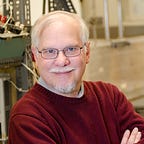No Hugs or handshakes: A scientific conference in the age of coronavirus
I have been attending scientific conferences of various kinds over my entire career. Some things have changed over the decades; most notably (and thankfully) PowerPoint has replaced 35 mm slides. But the overall structure has not changed. There are short talks, generally fifteen minutes long, presented consecutively from a podium and illustrated by slides. Often there are competing sessions organized around specific themes. There are sometimes plenary talks, where a distinguished member of the profession speaks at length on a topic of general interest. Accompanying the oral presentations are poster sessions, where anxious presenters, often students, will stand in front of their posters and try to attract the interest of meeting participants strolling past. These are usually separated in time from the oral sessions, to increase attendance.
The presentation of cutting-edge science is only part of the meeting, however. The other part is intensely social. Older scientists meet up, catch up on their current work, their students, and their personal lives. Hugs and handshakes are exchanged. They will bring promising young researchers to each other’s attention. Younger scientists meet each other for the first time, sometimes beginning a life-long collaboration. All of them plan future research projects. These interactions occur over formal and informal meals, over coffee, or just sitting down outside a room where a presentation is occurring. It is a given that you will miss talks that you intended to hear. These interactions build a community of researchers that feels like an extended family.
The outbreak of Covid-19 has been an earthquake for nearly all aspects of professional and personal life. The scientific conference has been no exception. Many have been cancelled, others are playing wait and see. And still others, like many other activities, have gone totally online. I have just participated in one of these, that of the International Association for Landscape Ecology — North American regional association (IALENA). Planned to be held in Toronto from May 10–14, the meeting organizers scrambled to convert it into a “remote virtual conference” http://www.ialena.org/annual-meeting.html. Amazingly, given the short time span they had, they pulled it off. My hats off to them; the amount of work needed to do this was amazing. The communication about arrangements before and throughout the conference was excellent. That it went off with only minor flaws is impressive!
How well did the virtual conference reflect the look, feel, and mission of the established in-person meeting? My feelings are mixed. There were real time plenaries and symposia on Zoom. As a vehicle for transmission of scientific information they worked well. In some ways, especially the ability to use various “chat” functions to leave questions and comments, they worked better than the standard format, where there is often little or no time for discussion.
Instead of the usual poster session, there were “IPosters.” These were online, in a basic poster format, but with the ability to add videos and audio narration as well as active links. I found it easy and intuitive to prepare my IPoster. All of these were displayed as a matrix in a searchable screen, so that you could scroll through and search posters of interest. Again, as a medium for conveying scientific information they were excellent. And it is great that they will be available for attendees for a year after the meeting. But they were not good vehicles for the social communication of science. Each poster session was assigned a “chat time,” where discussions were supposed to be posted on a chat screen. These chat times overlapped the symposia, so you could not do both. You also could not have true face-to-face interactions, including the serendipitous meeting of multiple people at a poster, that lead to exciting discussions and is the meat and potatoes of a good poster session. I have no idea how many people saw my poster or if they found it interesting or not.
And of course, a virtual meeting cannot adequately replicate the social interactions that make meetings so much fun. When I first attended an IALE meeting in 1995, I found that not only was the science exciting, but this was a great group of people to interact with. Given the structure of the virtual meeting, I could not run into old friends and colleagues or make new ones over a meal or beer. Of the 320 people at the meeting, I did not have a prolonged interaction with any of them. No hugs, no handshakes (although we may never do that again, even in a physical conference).
The organizers did the best they could. There was an online event where established scientists were paired with students, to act as informal mentors. This was fun, and I think the students benefited (I got thank you e-mails). There was also a round robin of ten-minute get-acquainted sessions, again fun, but you could not get beyond the superficial “who are you and what do you work on?” I also missed the field trips, which have always been a highlight of IALE meetings.
Would I do another virtual conference? It depends. IALENA was only three days long and was relatively small. That is about as many days sitting in front off a screen that I could stand. It was cheap, since I did not have to pay for a flight, a hotel room, or meals out. But much of the fun of going to a meeting is to visit a new city and having a nice meal with colleagues old and new. And nothing virtual can replace the intense chats in the hallway or the excitement of standing in front of a poster with a promising but nervous student. As most of us now know, zooming with your family does not replace being in the same room. The same is true of our academic families.
